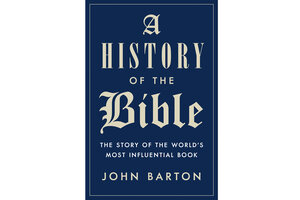‘A History of the Bible’ offers scholarly insights into its construction
Theologian and Anglican priest John Barton takes a well-researched look into the context and composition of the Bible.

“A History of the Bible: The Story of the World’s Most Influential Book” by John Barton, Viking, 608 pp.
Courtesy of Penguin Random House
Theologian, Anglican priest, and author John Barton knows the inherent complications involved in doing a serious history or textual analysis of the Bible. For millions of people, the Bible is more than just an anthology of ancient Near Eastern texts, it’s the divinely sanctioned or divinely authored word of God. For a small percentage of these people, any kind of disinterested literary or archeological inquiry smacks of sacrilege – and always has: Five hundred years ago, the Dutch humanist Desiderius Erasmus engaged in the monumental task of creating a scholarly translation of the New Testament into Greek and he encountered the same resistance to the very act of treating Scripture as text.
According to Barton, this resistance organizes itself around five principles: that the Bible is true, that it’s relevant, that it’s profound, that it’s internally consistent, and, perhaps most centrally, that there’s a direct line from the Bible to the current practice of the faith. Right at the onset of his book, Barton addresses this last directly: “In truth, there are no versions of either Christianity or Judaism that correspond point for point to the contents of the Bible.”
It’s a bracing sentiment, and it carries throughout Barton’s immensely impressive book, “A History of the Bible: The Story of the World’s Most Influential Book,” which urges the point that any serious study of the res Scripturae must start with the assumption that the Bible can be examined through a scholarly lens.
Robert Carroll and Stephen Prickett, in their magisterial edition of the King James Bible, refer to the Bible as “a book essentially in exile from its original context,” and in these pages, Barton seeks to provide a comprehensive history of that context, sorting the earliest origins of the many individual segments (of all genres: poetry, prophecy, historical epics, mythology) that were assembled over the course of centuries and tracing the developments of the various synods that shaped what would eventually become the fixed canon. Barton studies the order of the individual books of the Bible and the best approximations of how those specific books and no others were eventually included.
As Barton’s opening contentions make clear, his book contains sobering appraisals. Writing about the Synoptic Gospels, for instance, he stresses both the very human elements – Matthew and Luke updating Mark and correcting his errors in the process – and the troubling unknowns: “Despite centuries of research they remain an enigma, and those who revere them should be aware of how much we do not know about their composition.” He likewise analyzes earlier studies of the Bible along with famous scholars, including both Erasmus and his Protestant Reformation sparring opponent Martin Luther, whose own personal hermeneutic is given in typically artful terms: “The Bible is not there primarily to make us good, but to reveal to us how bad we are, and then to show us how God nevertheless saves us through Christ.”
Barton writes it all with smooth erudition and vast scholarship (his Notes and Bibliography run for a hundred pages), and his account inevitably comes down to a prolonged discussion of modern Christianity. He proposes an elegantly simple metaphor to help things along: two intersecting circles, one representing the Bible and the other Christian faith. Each person might draw the area of intersection a bit differently, he concedes, but “problems arise when people insist that the Bible and the faith are simply coterminous, that there is only one circle.”
“A History of the Bible” is a confident, distinctly courteous performance, wary of overstatement and sure of its intellectual footing. No work of literature has a more fascinating life story than the Bible, and Barton has told it with a precision and insight that will make this the definitive account of the century.

